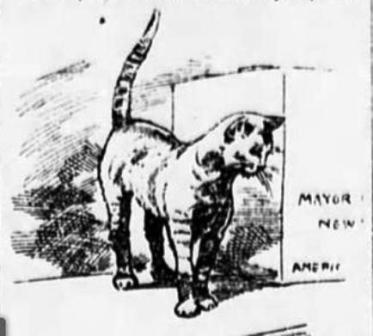
In 1893, America celebrated the 400th anniversary of Christopher Columbus’ arrival in the New World at the World’s Columbian Exposition in Chicago. One of the many guests of honor at the opening ceremonies was Cristóbal Colón de la Cerda, a descendant of Christopher Columbus and the 14th Spanish Duke of Veragua.
The Spanish Duke arrived in Chicago by way of New York City, where he spent several days touring the city with Mayor Thomas Francis Gilroy and other members of the city’s Columbus Reception Committee of One Hundred.
So what does Christopher Columbus, Mayor Thomas Gilroy, and a Spanish Duke have to do with an Irish cat from County Cork? Well, it is because of the Duke’s visit to America that this quaint story about an Irish cat named Miss Bridget Cork can be told. In fact, one could almost say this cat story is tied to the discovery of America. Okay, maybe I’m stretching it a bit, but I couldn’t resist the opportunity.
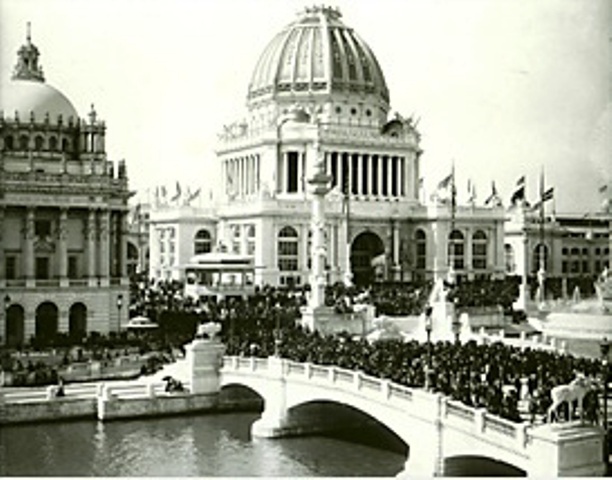
New York City, Washington, D.C., St. Louis, and Chicago had all vied to host the World’s Columbian Exposition. In fact, it was during this spirited competition that Charles A. Dana, editor of the New York Sun, dubbed Chicago “that windy city.” On April 25, 1890, President Benjamin Harrison signed the act that designated Chicago as the site of the exposition. The event was supposed to take place in 1892, but it took longer than expected to prepare and produce the exposition.
Our story begins on April 23, 1892, the day President Grover Cleveland sent the Duke of Veragua an invitation to attend the opening ceremonies at the World’s Columbian Exposition as a guest of the government and the people of the United States. The Duke arrived in New York a year later on April 15, 1893, aboard the American Line steamship appropriately named S.S. New York, accompanied by his wife, Dona Isabel de Aquilera, the Duchess of Veragua; his son, Don Cristobal Colon de Aguilara; his daughter, Dona Maria; his brother, the Marquis of Barbolis; and the Marquis’ son, Pedro Columbus de la Corda.

The first person to greet the Spanish Duke to America was U.S. Navy Commander Francis W. Dickins, who had been selected to represent the United States Government. Commander Dickins presented the Duke with the Freedom of the City (today we call this the Key to the City) and then escorted the royal family to the brand-new Waldorf Hotel on Fifth Avenue, which had opened only one month before in March 1893.
During his time in the city, the Spanish Duke and his family were guests of numerous grand receptions at City Hall, the Waldorf, and other locations throughout the city. The Duke of Veragua also visited Mayor Thomas F. Gilroy at his home in Harlem at 7 West 121st Street, took a tour through Central Park, and visited Grant’s Tomb.
Following a three-month stay in America, the Duke, his family, and their 92 shipping trunks departed New York on board the French liner La Bretagne. Despite being entertained by the city in a most elaborate fashion, the Spanish Duke reportedly left without giving the mayor or any other political dignitaries a thank-you letter or gift.
Commander Dickins apparently had better manners…
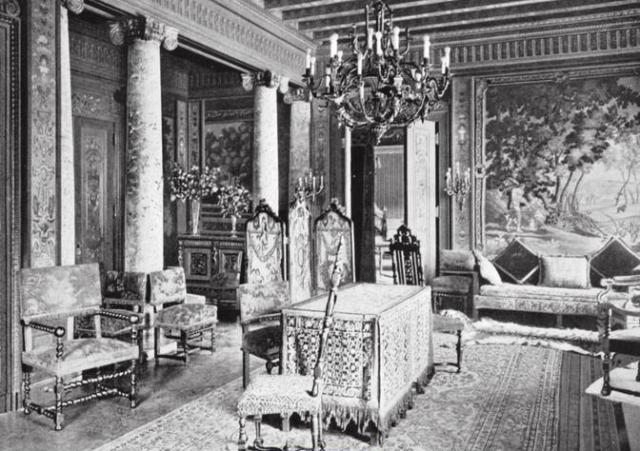
A Cat Arrives at City Hall
On February 14, 1894, a pine box with slats on top arrived at New York City Hall. Acting Secretary McDonough was not sure what to make of the box, and was even worried that it might contain a dangerous device.
“What is it?” asked Mayor Gilroy. “A cat!” McDonough replied, after hearing the cat meow. “By George, there’s a real Gaelic tone to her voice,” said one joker in the office. “Yes, and she has County Galway whiskers,” said another.
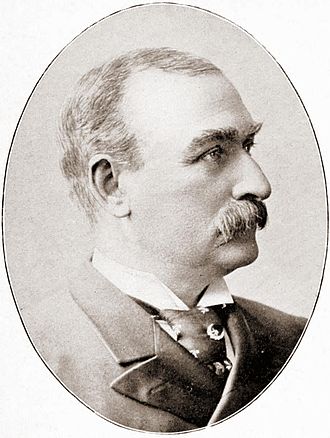
Inside the box was also a letter dated February 12, 1894, as follows:
My Dear Mayor Gilroy:
Last August I sailed from the United States, with the United States ship Monongahela under my command, for Queenstown, Ireland. Upon our arrival and during our stay there we received the most hearty welcome and gracious hospitality from all the Irish people, and particularly so from the gallant Mayor of Cork, the Hon. Augustine M. Roche.
Remembering your kindness to me in New York when I had the honor to represent the President of the United States in charge of the courtesies to the Duke of Veragua while he was the guest of the Nation, I wanted to bring back to you some token from that beautiful country, and the Mayor of Cork kindly gave me—not a tiger—but a gentle cat with a heart whose warmth is only exceeded by those of her countrymen.
Hence, I send to you today, by express, Miss Bridget Cork, accompanied by appropriate verses, composed by Mrs. Franklin Weld of Boston, with a chorus set to music. The clever lines I hope will please you, and that you will accept Miss Bridget with my profound gratitude, and with the best wishes for her welfare as well as your own, believe me to me, very sincerely yours, F.W. Dickins, Commander U.S.N.
Described in The New York Times as a handsome, good-natured purring cat, with a soft coat of dark gray and stripes of a darker hue, Bridget Cork had traveled from Queenstown to America with Commander Dickins on the SS Essex, which had arrived at the Norfolk Navy Yard on February 11. She then traveled by train to New York City in the pine box.
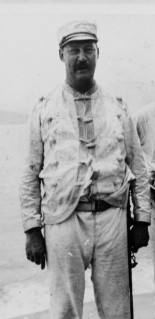
No one at City Hall could tell if the following verses composed by Mrs. Weld went to “Wearing of the Green,” “The Cat Came Back,” “Annie Laurie,” or any other song:
God speed to you, Captain Dickens, On your voyage across the sea!
Bear to Gilroy, Mayor of New York, The warmest of greetings from me.
From Ireland here to the Irish there, Good luck and comfort and care;
May they ne’er forget their country, In their homes across the sea.
The home land! The heart land! Through their homes are there, their hearts we share. Hurrah for the ould countrie! New York, ahoy! Here’s to Mayor Gilroy, to Roche and the Irish cat!
Writing is too cold and measured, And for words we are too far apart;
So warm hearts here send in greeting to you, A warm little Irish heart–
A symbol of comfort and luck, A real little Irish cat.
With Irish for pluck and a cat for luck, Can I send better than that?
The luck land! The pluck land! The Irish for pluck, the cat for luck. Hurrah for the Irish cat! New York, ahoy! Here’s to Mayor Gilroy, to Roche, and the Irish cat!
Although she wasn’t any match for Thomas Nast’s Tammany Tiger, Mayor Gilroy was quite pleased with the cat — and Bridget was quite pleased to be out of the box — but he knew there was no way she could stay at City Hall. After all, City Hall already had Tom, its brazen feline mascot, and Tom would never have accepted another cat in his territory.
So Mayor Gilroy sent Bridget to his home on West 121st Street, where I’m sure she received plenty of attention from the mayor’s ten children.
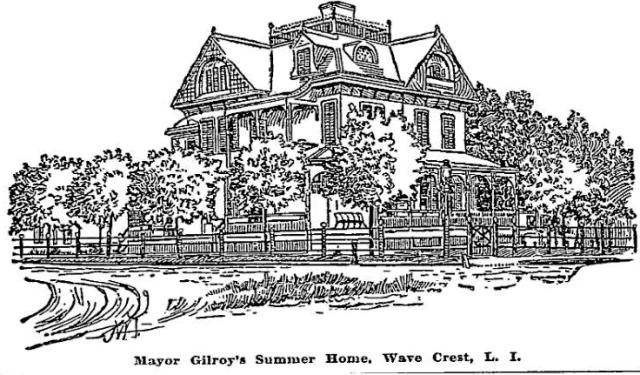
Perhaps Bridget Cork was lucky enough to spend her summers with the Gilory family at their home on Ocean Avenue (near present-day Ocean Crest Boulevard and Bay 32nd Street). The large white house with green trim fronted away from the shore, and from the back yard one could see the ocean, and in the distance, Sandy Hook, New Jersey. Thomas Gilroy died in this home on December 1, 1911. He was buried alongside his wife, Mary, at Woodlawn Cemetery in the Bronx.



